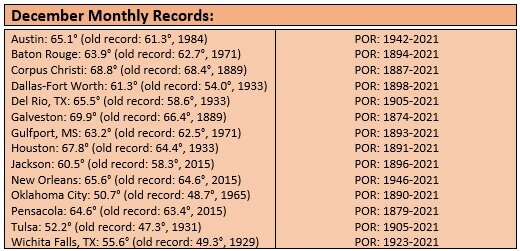-
Posts
22,608 -
Joined
Content Type
Profiles
Blogs
Forums
American Weather
Media Demo
Store
Gallery
Everything posted by donsutherland1
-
A snowstorm passed south of much of the region today. In New York City and Newark and northward, the clouds hung low and the wind picked up. But the dry air aloft squelched any falling snowflakes before they reached the ground. A spectacular sunset ended the daylight hours as the sun moved west of the retreating cloud deck before it slipped below the horizon. Meanwhile, southern New Jersey southward to central Virginia picked up a moderate to significant snowfall. In Atlantic City, Baltimore, and Washington, DC, visibility was reduced to a quarter mile or less at times. Some locations in Maryland and Virginia experienced thunder that accompanied the heavily falling snow. Snowfall amounts through 4 pm included: Atlantic City: 9.5" (old record: 2.8", 2014)--through 1 pm Baltimore: 6.8" (old record: 1.6", 1988) Islip: Trace Philadelphia: 0.5" Richmond: 2.0" Sterling: VA: 3.9" (old record: 0.9", 1989) Washington, DC: 6.7" (old record: 2.4", 1988) The last time Washington, DC picked up 6" or more snow while not even a trace was recorded in Central Park or Newark was March 16-17, 2014 when Washington received 7.2" of snow. The last time Atlantic City received 10" or more snow, as appears extremely likely given the amount at 1 pm, while no snow was reported in New York City or Newark was February 24, 1989 when Atlantic City was buried by 12.3" of snow. The snowstorm also set a record for highest snowfall the day after a 60° or above high temperature in Atlantic City. The previous record of 8.1" was set on February 17, 1967 following a 60° high temperature on the preceding day. In the wake of the storm, it will be sunny, blustery and cold. The high temperature will rise no higher than the middle or upper 30s across most of the region. Milder air will return on Wednesday ahead of the next cold front. January has commenced with an AO-/PNA- pattern. That typically favors somewhat cooler than normal readings in the East. For NYC, the January 1-10, 1991-2020 mean temperature for such cases was 33.5° (normal: 34.8°). This time around, the average will be warmer, but the overall tendency toward cooler weather will occur. By mid-month, New York City's temperature anomaly could be near or even somewhat below normal. Late in the first week of January, the PNA could go positive. As that happens, the prospects for measurable snowfall could increase throughout the region. Since 1990, 66% of days with 1" or more snow in New York City occurred when the PNA was positive. In addition, 81% of days with 4" or more snow occurred when the PNA was positive. Temperatures are now on a general path toward below seasonal figures. The coldest air will likely remain confined to the Pacific Northwest, Northern Plains, and western and central Canada through this week. Afterward, the cold could press farther south into at least the northern Middle Atlantic and Ohio Valley regions. Arctic air could reach the Middle Atlantic region during the second week of January. The colder pattern could last for two or perhaps three weeks before it breaks down. Thus, it could begin to break down sometime in the January 15-20 timeframe. The ENSO Region 1+2 anomaly was -1.5°C and the Region 3.4 anomaly was -1.0°C for the week centered around December 29. For the past six weeks, the ENSO Region 1+2 anomaly has averaged -1.33°C and the ENSO Region 3.4 anomaly has averaged -0.98°C. La Niña conditions will likely persist through meteorological winter. The SOI was +1.09 today. The preliminary Arctic Oscillation (AO) figure was -0.484 today. On January 1 the MJO was in Phase 7 at an amplitude of 2.064 (RMM). The December 31-adjusted amplitude was 2.042 (RMM).
-
Select snowfall totals through 1 pm EST: Baltimore: 6.8" (old record: 1.6", 1988) Washington, DC: 6.7" (old record: 2.4", 1988) The snowfall was also Washington, DC's highest daily snowfall following a day on which the temperature reached 63° or above. The old record was 5.7", which fell on February 17, 1967.
-
https://mesonet.agron.iastate.edu/lsr/
-
I'm glad everyone is ok. Be careful.
-
LWX1/3 9:00 AM AUGUSTA4 WSW STAUNTON VA SNOW 9.3 LWX1/3 10:20 AM AUGUSTA1 S WAYNESBORO VA SNOW 9.0
-
For reference: Select Daily Snowfall Records for January 3: Annapolis: 3.0", 1905 Baltimore: 1.6", 1988 Richmond: 7.7", 2002 Salisbury: 3.0", 2002 Sterling: 0.9", 1989 Washington, DC: 2.4", 1988 Miscellaneous: Washington, DC will likely see among its highest snowfall amounts the day following a high temperature of 63° or above (yesterday's high temperature). The five biggest such snowfalls are: 1. 5.7", February 17, 1967 2. 4.0", March 21, 1943 3. 3.3", March 16, 2014 4. 2.5", February 11, 1955 5. 1.9", March 24, 1990 The January mark is 1.5", which was set on January 20, 1915.
-
Morning thoughts… It will be mostly cloudy and cold today A storm passing to the south will bring a moderate to significant snowfall from Richmond to central New Jersey. Light snow is likely in New York City, Newark, and nearby suburbs. High temperatures will likely reach mainly the lower and middle 30s in most of the region. Likely high temperatures around the region include: New York City (Central Park): 34° Newark: 33° Philadelphia: 33° Snowfall estimates include: Atlantic City: 5"-10" Baltimore: 3"-6" Islip: 1"-2" New York City-JFK: 1”-2” New York City-LGA: 0.5” or less New York City-NYC: 0.5" or less Newark: 0.5" or less Norfolk: 1" or less Philadelphia: 2"-4" Richmond: 3"-6" Salisbury: 4"-8" Washington, DC: 4"-8" Wilmington, DE: 3"-6"
-
Thank you, RJAY.
-
I will do so. Thanks.
-
Yes. I think the storage capacity drops when the subscription expires.
-

january 3rd potential coastal grazer
donsutherland1 replied to forkyfork's topic in New York City Metro
The 500 mb pattern is fairly similar to that of January 22, 1954, along with similar teleconnections (AO-, NAO+, PNA+). The January 22-23, 1954 storm brought 6.4" to Washington, DC, but just 0.3" to Philadelphia and no snow to New York City. I don't think the gradient will be quite that sharp this time around, e.g., I think Philadelphia will see 2"-4", Central Park 0.5" or less and the JFK/southern Brooklyn, and Staten Island could see 0.5" to perhaps an inch. -
I suspect you'll see 1"-2".
-
Noticeably colder air is now overspreading the region. Tomorrow will be variably cloudy, breezy, and cold. A snowstorm passing to the south could bring a period of light snow. Farther south, a moderate to significant snowfall is possible in parts of the Middle Atlantic region. Snowfall estimates include: Atlantic City: 5"-10" Baltimore: 3"-6" Islip: 1"-2" New York City: 0.5" or less Newark: 0.5" or less Norfolk: 1" or less Philadelphia: 2"-4" Richmond: 3"-6" Salisbury: 5"-10" Washington, DC: 4"-8" Wilmington, DE: 3"-6" Washington, DC will likely see among its highest snowfall amounts the day following a high temperature of 63° or above (today's high temperature). The five biggest such snowfalls are: 1. 5.7", February 17, 1967 2. 4.0", March 21, 1943 3. 3.3", March 16, 2014 4. 2.5", February 11, 1955 5. 1.9", March 24, 1990 The January mark is 1.5", which was set on January 20, 1915. Should Washington, DC receive measurable snow prior to the end of today, the coming storm would mark the first time on record that January saw measurable snowfall both on the day of a 60° or above high temperature and the day after, and only the 3rd time on record. This would also be the first case when the temperature reached 63° or above. January has commenced with an AO-/PNA- pattern. That typically favors somewhat cooler than normal readings in the East. For NYC, the January 1-10, 1991-2020 mean temperature for such cases was 33.5° (normal: 34.8°). This time around, the average will be warmer, but the overall tendency toward cooler weather will occur. By mid-month, New York City's temperature anomaly could be near or even somewhat below normal. Late in the first week of January, the PNA could go positive. As that happens, the prospects for measurable snowfall could increase. Since 1990, 66% of days with 1" or more snow in New York City occurred when the PNA was positive. In addition, 81% of days with 4" or more snow occurred when the PNA was positive. The latest guidance continues to suggest that temperatures could head toward seasonal levels and then below seasonal levels as the first week of January progresses. The coldest air will likely remain confined to the Pacific Northwest, Northern Plains, and western and central Canada during that time. Afterward, the cold could press farther south into at least the northern Middle Atlantic and Ohio Valley regions. Modified Arctic air could reach the Middle Atlantic region during the second week of January. The colder pattern could last for two or perhaps three weeks before it breaks down. Thus, it could begin to break down sometime in the January 15-20 timeframe. The ENSO Region 1+2 anomaly was -1.3°C and the Region 3.4 anomaly was -1.1°C for the week centered around December 22. For the past six weeks, the ENSO Region 1+2 anomaly has averaged -1.25°C and the ENSO Region 3.4 anomaly has averaged -0.98°C. La Niña conditions will likely persist through meteorological winter. The SOI was -2.11 today. The preliminary Arctic Oscillation (AO) figure was -0.484 today. On December 31 the MJO was in Phase 7 at an amplitude of 2.044 (RMM). The December 30-adjusted amplitude was 1.887 (RMM).
-
Thank you.
-
ATTN: RJAY I am trying to renew my subscription, but keep receiving error messages. I suspect it has to do with my credit card being on file and my trying to use the updated on with a later expiration date. Please advise.
-
Error message keeps occurring when I try to pay for the subscription. Please advise, Don
-
Morning thoughts… It will be mostly cloudy and unseasonably mild today. Temperatures will fall rapidly late in the day or at night. High temperatures will likely reach mainly the middle and upper 50s in most of the region. Likely high temperatures around the region include: New York City (Central Park): 55° Newark: 58° Philadelphia: 62° A developing storm will bring a moderate snowfall to parts of the Middle Atlantic region late tonight and tomorrow. There has been a pronounced increase in snowfall amounts to the north on the overnight EPS. The differences between the 1/1 12z and 1/2 0z runs include: New York: 0% 1”; 29% 1”; Philadelphia: 4% 2”; 57% 2”; Washington, DC: 6% 4”; 63% 4”. Initial snowfall estimates include: Atlantic City: 4”-8”; Baltimore: 3”-6”; Islip: 1”-2”; New York City: 0.5” or less; Newark: 1” or less; Norfolk: 1” or less; Philadelphia: 2”-4”; Richmond: 3”-6”; Salisbury: 4”-8”; Washington, DC: 3”-6”; and, Wilmington, DE: 3”-6”
-
2022 has begun with more unseasonable warmth. But a turn toward colder weather lies ahead in the medium-range. After an warm start tomorrow, temperatures will tumble late in the day. In the South, more near record and record heat prevailed for a final day of what has been an extraordinary month-long period of exceptional warmth. Preliminary records included: Birmingham: 80° (old record: 78°, 1952) Brownsville: 89° (old record: 83°, 1955 and 1989) Corpus Christi: 92° (old record: 84°, 2006) ***Tied January Record*** Galveston: 81° (old record: 76°, 1934) ***New January Record*** Houston: 85° (old record: 81°, 1917 and 2006) ***New January Record*** Jackson: 85° (old record: 81°, 1952) ***Tied January Record*** Mobile: 79° (tied record set in 1975) Montgomery, AL: 83° (old record: 79°, 1952) ***Tied January Record*** New Orleans: 82° (old record: 81°, 2006) January has commenced with an AO-/PNA- pattern. That typically favors somewhat cooler than normal readings in the East. For NYC, the January 1-10, 1991-2020 mean temperature for such cases was 33.5° (normal: 34.8°). Late in the first week of January, the PNA could go positive. As that happens, the prospects for measurable snowfall could increase. Since 1990, 66% of days with 1" or more snow in New York City occurred when the PNA was positive. In addition, 81% of days with 4" or more snow occurred when the PNA was positive. The latest guidance suggests that temperatures could head toward seasonal levels and then below seasonal levels as the first week of January progresses. The coldest air will likely remain confined to the Pacific Northwest, Northern Plains, and western and central Canada during that time. Afterward, the cold could press farther south into at least the northern Middle Atlantic and Ohio Valley regions. The colder pattern could last for two or perhaps three weeks before it breaks down. Thus, it could begin to break down sometime in the January 15-20 timeframe. The ENSO Region 1+2 anomaly was -1.3°C and the Region 3.4 anomaly was -1.1°C for the week centered around December 22. For the past six weeks, the ENSO Region 1+2 anomaly has averaged -1.25°C and the ENSO Region 3.4 anomaly has averaged -0.98°C. La Niña conditions will likely persist through meteorological winter. The SOI was +3.82 today. The preliminary Arctic Oscillation (AO) figure was -1.338 today. On December 30 the MJO was in Phase 7 at an amplitude of 1.889 (RMM). The December 29-adjusted amplitude was 2.049 (RMM).
-
-
-
In the Northeast, both Newark and Boston saw their warmest year on record in 2021. Boston: 54.6 (old record: 54.2, 2012) Newark: 58.1 (old record: 57.9, 2012)
-
Morning thoughts... Today will be cloudy, rainy, and mild. Temperatures will likely reach the middle and even upper 50s across much of the region. Likely high temperatures include: New York City (Central Park): 54° Newark: 57° Philadelphia: 59° Tomorrow will start mild, but temperatures will fall sharply late in the day. 30-Day Verification: New York City (Central Park): Average daily forecast: 48.4° Average temperature: 48.3° Average error: 1.1° Newark: Average daily forecast: 51.2° Average temperature: 50.4° Average error: 1.6° Philadelphia: Average daily forecast: 52.5° Average temperature: 52.0° Average error: 1.6°








